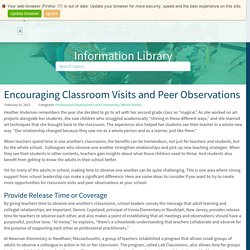

Professional Development: Visiting Other Teachers. By Kaitie O’Bryan I visited two Knowles Teaching Fellows at a school that uses problem-based learning.

Quick info: I visited a school using a strategy I wanted to implement with Linda Abrams (KSTF Program Officer, Teacher Development) and another 2012 Teaching Fellow. Encouraging Classroom Visits and Peer Observations. Heather Anderson remembers the year she decided to go to art with her second grade class as “magical.”

As she worked on art projects alongside her students, she saw children who struggled academically “shining in these different ways,” and she learned art techniques that she brought back to the classroom. The experience also helped her students see their teacher in a whole new way. “Our relationship changed because they saw me as a whole person and as a learner, just like them.” When teachers spend time in one another’s classrooms, the benefits can be tremendous, not just for teachers and students, but for the whole school.
Colleagues who observe one another strengthen relationships and pick up new teaching strategies. Teachers Observing Teachers: A Professional Development Tool for Every School. Typically evaluative by nature, teacher observation is usually linked to classroom performance.

More and more schools, however, are using observation -- teachers observing teachers -- as a form of professional development that improves teaching practices and student performance. In this article, Education World's Michele Israel talks with experts about the benefits of this emerging professional development strategy. Included: The benefits of learning by observing -- for the teacher, administrator, and school, plus five observation models. Being observed in the classroom can rattle any teacher's nerves. But, teacher observations that serve as vehicles for professional growth rather than performance evaluations have multiple benefits -- for teachers, administrators, and the school.